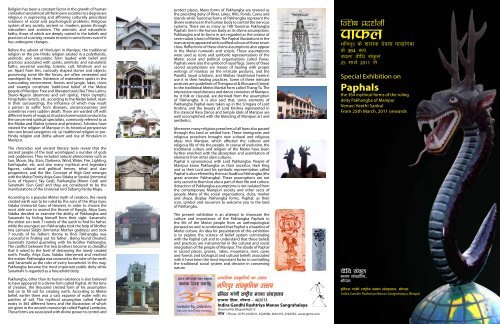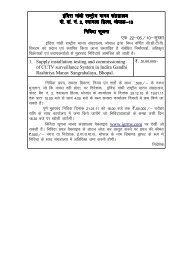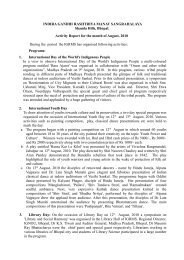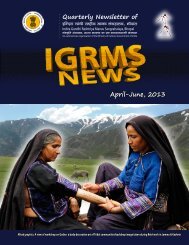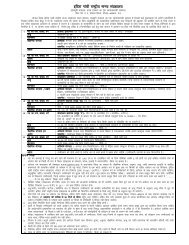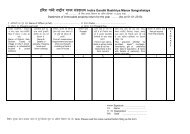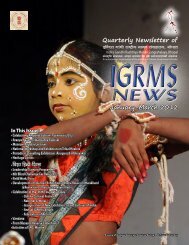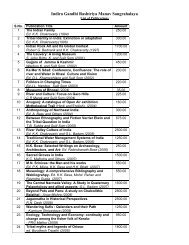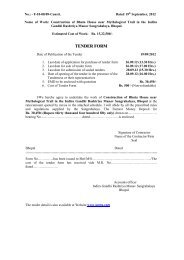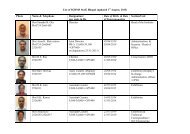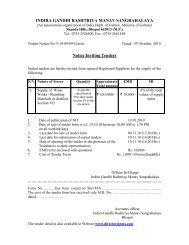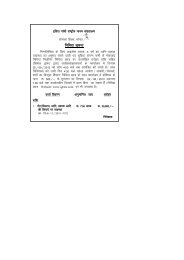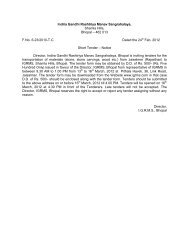Create successful ePaper yourself
Turn your PDF publications into a flip-book with our unique Google optimized e-Paper software.
Religion has been a constant factor in the growth of human<br />
civilization and almost all the known societies to a degree are<br />
religious in expressing and affirming culturally prescribed<br />
solutions of social and psychological problems. Religious<br />
system of any society, ancient or modern, passes through<br />
naturalism and animism. The animistic and naturalistic<br />
faiths, those of which are deeply rooted in the beliefs and<br />
practices of a society, remain to exist in some forms even if it<br />
has undergone changes.<br />
Before the advent of Hinduism in Manipur, the traditional<br />
religion or the pre-Hindu religion existed in a polytheistic,<br />
animistic and naturalistic form loaded with belief and<br />
practices associated with spirits, animistic and naturalistic<br />
faiths, ancestral worship, totemic cult, fetishism and so<br />
on. Apart from this, curiously shaped stones and objects,<br />
possessing some life-like forces, are often venerated and<br />
worshiped by them. Existence of malevolent spirits in the<br />
surrounding environment, forests and jungle, lakes, rivers<br />
and swamps constitute traditional belief of the Meitei<br />
people of Manipur. Free and liberated souls like Timu-Laimu,<br />
Sharoi-Ngaroi (deomons and evil spirits), Heloi (nymph),<br />
Hingchabis (witch), etc. according to the Meitei belief, roam<br />
in their surroundings, the influence of which may result<br />
a person to suffer from diseases, unconsciousness and<br />
sometimes meet sudden death. These are warded off with<br />
different levels of magical, ritual and ceremonial conducts by<br />
the concerned spiritual specialists, commonly referred to as<br />
the Maiba and Maibis (priests and priestess). Scholars have<br />
viewed the religion of Manipur in its historical perspective<br />
into two broad categories viz. (a) traditional religion or pre-<br />
Hindu religion and (b)the advent and rise of Hinduism in<br />
Manipur.<br />
The chronicles and ancient literary texts reveal that the<br />
ancient people of the land worshipped a number of gods<br />
and goddesses. They included natural phenomena such as<br />
Sun, Moon, Sky, Stars, Darkness, Wind, Water, Fire, Lighting,<br />
Earthquake, etc. and also many mythical and legendary<br />
figures, cultural and political heroes, tribal and clan<br />
progenitors, and the like. Concept of High God emerges<br />
with the Meitei Trinity Atiya Guru Sidaba or Soralel (immortal<br />
Guru of Heaven/ Sky God), Pakhangba (Moon God) and<br />
Sanamahi (Sun God) and they are considered to be the<br />
manifestations of the Universal lord Taibang Panba Mapu.<br />
According to a popular Meitei myth of creation, the newly<br />
created earth was to be ruled by the sons of the Atiya Guru<br />
Sidaba (immortal Guru of Heaven). In order to choose the<br />
most able son to ascend the thorne of Kangla, Atiya Guru<br />
Sidaba decided to examine the ability of Pakhangba and<br />
Sanamahi by hiding himself from their sight. Sanamahi,<br />
the eldest son took 7 rounds of the earth to find his father,<br />
while the youngest son Pakhangba took the help of Mother<br />
Ima Leimarel Sidabi (Immortal Mother goddess) and took<br />
7 rounds of his father’s throne to find. Pakhangba was<br />
successful in finding out his father . Being found cheated,<br />
Sanamahi started quarreling with his brother Pakhangba.<br />
The conflict between the two brothers become so dreadful<br />
that it raised to the level of destroying the newly created<br />
earth. Finally, Atiya Guru Sidaba intervened and resolved<br />
the matter. Pakhangba was crowned as the ruler of the earth<br />
and Sanamahi as the ruler of every household. In this way,<br />
Pakhangba became the most important public deity while<br />
Sanamahi is regarded as a household deity.<br />
Pakhangba, other than its human existence is also believed<br />
to have appeared in a divine form called Paphal. At the time<br />
of creation, the thousand crested form of his assumption<br />
laid on to fill soil for creating earth. According to Meitei<br />
belief, earlier there was a vast expanse of water with no<br />
patches of soil. This mythical assumption called Paphal<br />
exists in 364 different forms and the illustration of which<br />
are given in the ancient manuscript called Paphal Lambuba.<br />
These forms are associated with divine power to control and<br />
protect places. Many forms of Pakhangba are revered as<br />
the presiding deity of River, Lakes, Hills, Ponds, Caves and<br />
Islands while Taoroinai forms of Pakhangba represent the<br />
divine existence in the human body to control the nervous<br />
systems. There are as many as 108 Taoroinai Pakhangba<br />
Paphals live in the human body as its divine assumptions.<br />
Pakhangba and its forms in are regarded as the creator of<br />
seven salais (clans) of Meitei. The Paphal illustrations in the<br />
manuscripts appeared with codified colours of these seven<br />
clans. Reflections of these divine assumptions also appear<br />
in the Meitei numerals and scripts. These assumptions<br />
were used as icons and symbolic representations of the<br />
Meitei social and political organisations called Panas.<br />
Paphals were also the symbol of royal flags. Some of these<br />
sacred assumptions are means of healing with proper<br />
writings of mantras on the intricate postures, and the<br />
Pandits (royal scholars), and Maibas (traditional healers)<br />
use it in their healing practices. Some of these intricate<br />
postures are guidelines of Thengourol & Khousarol (steps)<br />
to the traditional Meitei Martial form called Thang-Ta. The<br />
impressive royal dressess and dance costumes of Manipur,<br />
be it folk or classical, are derrived from the assumption<br />
of Pakhangba. It is also said that, some elements of<br />
Pakhangba Paphal were taken up in the Sringara of Lord<br />
Krishna, and the beauty of Lord Krishna represented in<br />
the classical Rasa Dance and temple idols of Manipur are<br />
well accomplished with the blending of Manipuri art and<br />
aesthetics.<br />
Moreover, many religious preachers of all hues also passed<br />
through this land or settled here. These immigrants and<br />
religious preachers brought new cultural and religious<br />
ideas into Manipur, which affected the cultural and<br />
religious life of the the people. In course of evolution, the<br />
traditional culture and religion of the Meitei have been<br />
further enriched with the absorption and assimilation of<br />
elements from other alien cultures.<br />
Paphal is synonymous with Lord Pakhangba. People of<br />
Manipur know Pakhangba as their ancestor, their King<br />
and as their Lord and his symbolic representation called<br />
Paphal is also referred by them as Ibudhou Pakhangba (the<br />
great ancestor Pakhangba). These assumptions are not<br />
only sacred to them but also a part of their life and culture.<br />
Attraction of Pakhangba assumptions is not isolated from<br />
the contemporary Manipuri society and other sects of<br />
people. Many of the social organisations, clubs, market<br />
and shops, display Pakhangba forms, ‘Paphal’, as their<br />
icon, symbol and souvenirs to welcome you to the land<br />
of Pakhangba.<br />
The present exhibition is an attempt to showcase the<br />
culture and importance of the Pakhangba Paphals in<br />
the life of the Meitei people from an anthropological<br />
perspective and to understand that Paphal is a baseline of<br />
Meitei culture. An idea for presentation of this exhibition<br />
is to explore the science of belief system culminating<br />
with the Paphal cult and to understand that these beliefs<br />
and practices are instrumental in the cultural and social<br />
integration of the people of Manipur. The abode of Paphal<br />
in sacred places, groves, lakes, mountains, river, caves<br />
and forests and biological and cultural beliefs associated<br />
with it have been the most important factor in controlling<br />
the traditional social system and decisive in conserving<br />
nature.<br />
+ÉÆSɇ±ÉEò ºÉƺEÞò‡iɪÉÉå EòÉ =iºÉ´É<br />
¨É‡hÉ{ÉÖ®ú ºÉÉƺEÞò‡iÉEò =iºÉ´É<br />
bfUnjk xka/kh jk"Vªh; ekuo laxzgky;<br />
'kkeyk fgYl] Hkksiky & 462013<br />
Indira Gandhi Rashtriya Manav Sangrahalaya<br />
Shamla Hills, Bhopal-462013<br />
Qksu / Phone : 0755-2526531, 2526580, 2661319, 2526550; www.igrms.com<br />
δɄÉä¹É |Énù„ÉÇxÉÒ<br />
{ÉÉ¡ò±É<br />
¨É‡hÉ{ÉÖ® ds 'kkld nsork ik[kkaxck<br />
ds 364 :i<br />
ºlɱÉ& ´ÉÒ‡lÉ ºÉÆEÖò±É<br />
25 ¨ÉÉSÉÇ 2011 ºÉä<br />
Special Exhibition on<br />
Paphals<br />
the 364 mythical forms of the ruling<br />
deity Pakhangba of Manipur<br />
Venue: Veethi Sankul<br />
From 25th March, 2011 onwards<br />
ohfFk ladqy<br />
ekuo laxzgky;]<br />
Hkksiky<br />
bfUnjk xka/kh jk"Vªh; ekuo laxzgky;] Hkksiky<br />
Indira Gandhi Rashtriya Manav Sangrahalaya, Bhopal
Ekkuo lH;rk ds fodkl esa /keZ dh ,d fuf’pr Hkwfedk jgh gS vkSj yxHkx lHkh Kkr<br />
lektksa dh vfHkO;fDr esa ,d lhek rd /kkfeZd gS vkSj lkekftd rFkk euksoSKkfud<br />
leL;kvksa ds lek/kku gsrq lkaLd`frd :i ls ekU; fu;e dk ikyu djrs gSaA vk/kqfud<br />
;k izkphu fdlh Hkh lekt dh /keZ O;oLFkk izd`frokn vkSj czge~okn ls xqtjrh gSA muds<br />
czEgoknh vkSj izd`froknh vkLFkk,Wa tks lekt ds fo’okl vkSj vfHkfdz;kvksa ls xgu<br />
laca) gS] dfri; ifjorZuksa ds ckotwn Hkh vfLrRoeku jgrh gSaA<br />
ef.kiqj esa fgUnw /keZ ds izknqHkkZo ds iwoZ ikjEifjd /keZ ;k fgUnw iwoZ /keZ cgqnsookn<br />
vfLrRoeku Fkk] czEgoknh vkSj izd`froknh :i fo’oklksa vkSj deZdk.Mksa] vkRek ls lac)]<br />
iwoZt mikluk] VksVe iaFk] tknw Vksus fo’okl bR;kfn ls Hkjk FkkA<br />
blls fHkUu ;k i`Fkd thou HkfDr ;qDr fofp=


